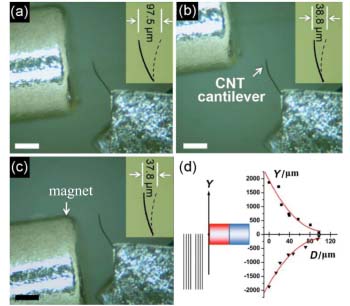Giant magnetic moment at open ends of multiwalled carbon nanotubes

Giant magnetic moment at open ends of multiwalled carbon nanotubes |
| Fig. 4. Symmetric deflections of a cut-off CNT cantilever along the y -axis, indicating that the point of application of force is at the tip of the cantilever. In the insets, the solid and dashed lines not in scale correspond to the positions of the cantilever in panels a, b, c and its original position, respectively. a At #cod#x201C; y #cod#x003D; 0#cod#x201D;, the deflection of the CNT cantilever has the maximum value. b and c When the magnet is moved to positions of #cod#x201C; y #cod#x003D; 0.8 mm#cod#x201D; b and #cod#x201C; y #cod#x003D; #cod#x2013;0.8 mm#cod#x201D; c 0.8 mm, radius of the cylindrical magnet, the deflection of the CNT cantilever has almost the same value. d Definitions of #cod#x201C; y -axis#cod#x201D; left and the #cod#x201C; y -D#cod#x201D; curve right. The deflection of CNT cantilever is symmetric on the y -axis, indicating that the point of application of force is at the tip of the cantilever; therefore, the magnetic moment is at the open ends of the CNTs. |
 |